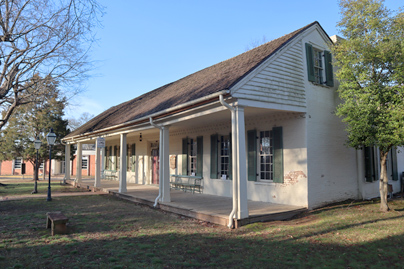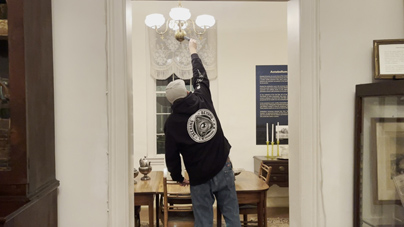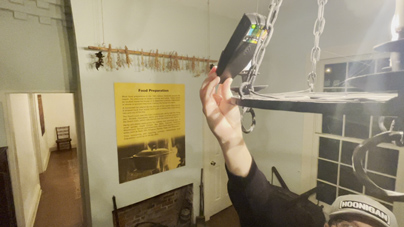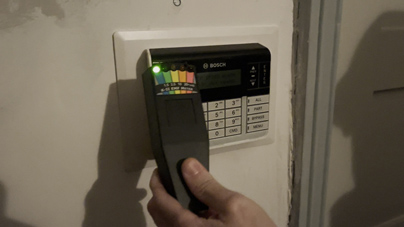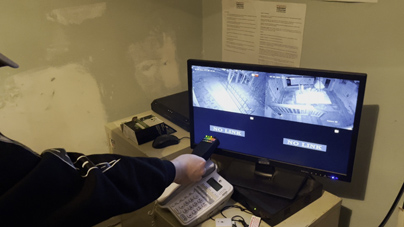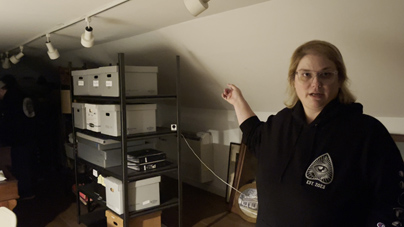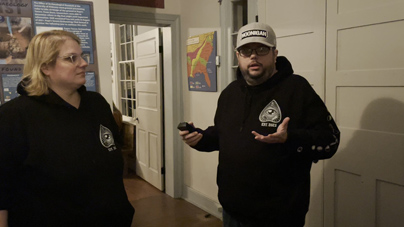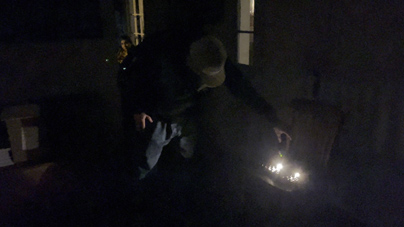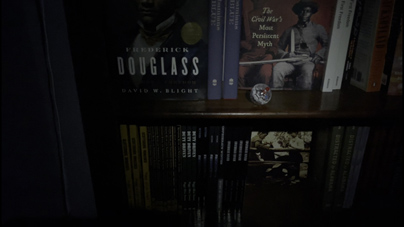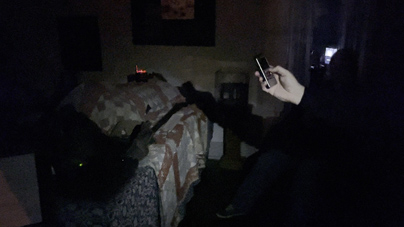Pope's Tavern Museum
February 2, 2024 | 7:00pm to Midnight
The Claims | Equipment and Setup | The Investigation | Our Results
Pope's Tavern is a small historical house in Florence, Alabama that has served as a museum since 1968. It has a rich history, having been originally constructed in 1811 as a stagecoach stop and inn, seven years before the founding of Florence itself. A fire destroyed the structure sometime in the 1810s, and a new structure was erected in the 1820s, which remains as the Southeastern portion of the current house. Over the years, it has served as several residences, a hospital during the American Civil War, and a boarding house.
Some of the specifics of the house's history are rather muddy, and archaeological efforts are still recovering new artifacts and information. However, its history as a hospital is particularly notable, especially where potential paranormal activity is concerned. The exact number of soldiers treated in the house is unknown, but the Historical Marker Database reports that 32 soldiers died of their wounds onsite. Certainly, all manner of death has the potential to leave spiritual energy behind, so we can't ignore the possibility of any of the house's past residents still occupying the space. The potential for wayward spirits and lingering energy increases dramatically, though, with the added context of the horrific battles and gruesome wounds that brought those soldiers to the hospital, and the crude and painful treatments administered within.
The Claims
The claims of paranormal activity at Pope's Tavern run the gamut of paranormal phenomena, though many of those claims come from unverifiable sources, such as online comments where exaggeration often runs rampant. These claims include disembodied footsteps, knocking noises, moans and screams, apparations including a female nurse and soldiers with amputations, and disappearing bloodstains on the floor. Additionally, the current management reports the sounds of someone entering through the front door and walking into the central room, as well as a mysteriously displaced book from a bookshelf next to that same door.
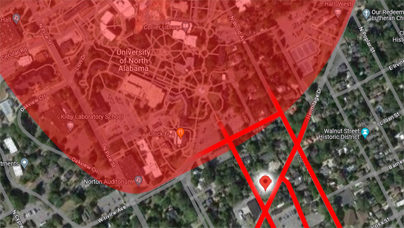 Most (if not all) of these claims certainly fall well within the realm of documented paranormal phenomena, but certain
circumstances rule some of them out right off the bat (or in the very least make them unverifiable).
On Saturday, November 18, 2023 we visited Pope's Tavern and met with the current management to get a brief walkthrough
and review the claims. One of the first things we noticed was how close the house was to the roads, sitting on a corner
lot in a rather well-travelled portion of town. Worth noting, Pope's Tavern is located less than a block
away from the University of North Alabama, and you can hear campus activity from inside the house almost clearly.
Additionally, being a very old house, it has very little noise-proofing and no insulated windows. Naturally, people
walking down the sidewalks right outside can be heard quite clearly, so we'd be hard-pressed to confirm any of the voice
phenomena as being paranormal in nature. Even the claims of knocking and popping sounds in the house can be ruled out
or considered unverifiable as being paranormal because of structure itself — it has historically-accurate wood floors,
which creak and pop from occupant movement, structural settling, and expansion/contraction from temperature and moisture changes.
Objectively speaking, this isn't to say such phenomena doesn't happen, but with regards to any sort of paranormal investigation,
the house suffers from an egregious amount of noise pollution making those claims difficult to investigate
even under the best of circumstances.
Most (if not all) of these claims certainly fall well within the realm of documented paranormal phenomena, but certain
circumstances rule some of them out right off the bat (or in the very least make them unverifiable).
On Saturday, November 18, 2023 we visited Pope's Tavern and met with the current management to get a brief walkthrough
and review the claims. One of the first things we noticed was how close the house was to the roads, sitting on a corner
lot in a rather well-travelled portion of town. Worth noting, Pope's Tavern is located less than a block
away from the University of North Alabama, and you can hear campus activity from inside the house almost clearly.
Additionally, being a very old house, it has very little noise-proofing and no insulated windows. Naturally, people
walking down the sidewalks right outside can be heard quite clearly, so we'd be hard-pressed to confirm any of the voice
phenomena as being paranormal in nature. Even the claims of knocking and popping sounds in the house can be ruled out
or considered unverifiable as being paranormal because of structure itself — it has historically-accurate wood floors,
which creak and pop from occupant movement, structural settling, and expansion/contraction from temperature and moisture changes.
Objectively speaking, this isn't to say such phenomena doesn't happen, but with regards to any sort of paranormal investigation,
the house suffers from an egregious amount of noise pollution making those claims difficult to investigate
even under the best of circumstances.
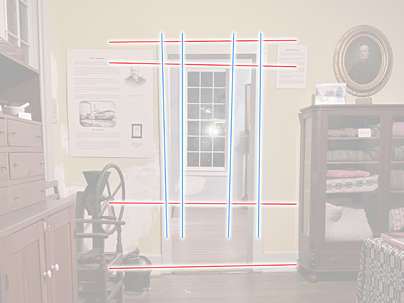 Furthermore, our initial walkthrough revealed that some of the rooms — such as the surgery room and the entire upstairs
— suffer from something called the funhouse effect. The funhouse effect describes a variety of
physiological responses one might have to physical settings like uneven flooring, unparallel walls, skewed perspectives,
and other odd or imperfect construction. Being in such spaces might make you dizzy, experience
balance issues, or exhibit symptoms of claustrophobia — and in extreme cases, might
even trigger responses like vertigo and hallucinations. When combined with certain additional
factors (such as being in a reportedly haunted house), one might be easily led to misinterpret that sense of imbalance as being
pulled or pushed by an unseen hand. While you may certainly become acclimated to the funhouse effect over time, we were newcomers
to the space so we experienced the effect throughout our time there.
Furthermore, our initial walkthrough revealed that some of the rooms — such as the surgery room and the entire upstairs
— suffer from something called the funhouse effect. The funhouse effect describes a variety of
physiological responses one might have to physical settings like uneven flooring, unparallel walls, skewed perspectives,
and other odd or imperfect construction. Being in such spaces might make you dizzy, experience
balance issues, or exhibit symptoms of claustrophobia — and in extreme cases, might
even trigger responses like vertigo and hallucinations. When combined with certain additional
factors (such as being in a reportedly haunted house), one might be easily led to misinterpret that sense of imbalance as being
pulled or pushed by an unseen hand. While you may certainly become acclimated to the funhouse effect over time, we were newcomers
to the space so we experienced the effect throughout our time there.
Equipment and Setup
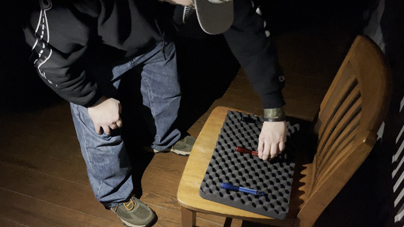 Upon arrival, we were met by staff who would remain with us for the duration, and we began setup. Our core set of
equipment is mostly mobile, so "setup" mostly meant scattering our 10 cat toys out
throughout the the house. However, we had our technology consultant Dianna with us, and she brought a
stationary GoPro camera and a movement-tracking action cam. Since the central room
is where the prominent activity occurs, she set up the action cam right next to the front door, with a GoPro in the
opposite corner of the room. Worth noting, about halfway through the evening, we added our laser grid
to the room, which the action cam would see. Outside of those two cameras keeping an eye on that room, the rest of
our setup generally consisted of our three MagLite Mini flashlights, our two EMF meters,
and our REM pod. We would use these items throughout the evening in every room we investigated.
Additionally, we added our voice recorder into the mix halfway through the evening, and wrapped
up the night with four Estes Method sessions.
Upon arrival, we were met by staff who would remain with us for the duration, and we began setup. Our core set of
equipment is mostly mobile, so "setup" mostly meant scattering our 10 cat toys out
throughout the the house. However, we had our technology consultant Dianna with us, and she brought a
stationary GoPro camera and a movement-tracking action cam. Since the central room
is where the prominent activity occurs, she set up the action cam right next to the front door, with a GoPro in the
opposite corner of the room. Worth noting, about halfway through the evening, we added our laser grid
to the room, which the action cam would see. Outside of those two cameras keeping an eye on that room, the rest of
our setup generally consisted of our three MagLite Mini flashlights, our two EMF meters,
and our REM pod. We would use these items throughout the evening in every room we investigated.
Additionally, we added our voice recorder into the mix halfway through the evening, and wrapped
up the night with four Estes Method sessions.
During setup, we also conducted a sweep of the entire house, looking for anything emitting a high-enough electromagnetic field (EMF) that might interfere with our equipment. Using one of our EMF meters, we checked all available outlets, all lighting fixtures, anything with a power brick, wall switches, security panels, door sensors, and the fuze box. We even checked our own equipment, and had everyone put their smartphones in airplane mode, showing the difference in EMF activity when airplane mode is off and on. With the understanding that our K-II EMF meters do indeed have upper and lower detection thresholds, the only things we found in the house that set our meters off were the fuse box and a computer monitor in the back office, which 1) was in a room we didn't investigate, and 2) required the EMF meter to be practically touching the monitor for it to be set off. Our tech consultant Dianna, who is an expert and professional at installing various types of electrical equipment, noted that she found the house to be rather "electrically quiet," which was a good thing for the usage of our equipment during the investigation. That is to say, should our equipment go off at all during the investigation, we would know that nothing in the house was setting it off through ordinary operation.
That being said, we did have two odd occurences during our EMF sweep. The first occurred on our way back through the central room. When we approached the front door, Dianna noted that the motion-tracking action cam was watching something at the front door. We swept the area slowly with the EMF meter, and noted a quick "blip" on the LED indicator. It happened twice in the area, both times in open space, far from any outlet or piece of equipment, all of which had been previously vetted. While we checked the area, the action cam would track our movements, showing that it was functioning properly. Later on during data review, we found that the action cam was tracking something at the front door throughout the night. Please note, the date on the footage is incorrect.
The second odd occurence happened during our EMF sweep upstairs. Like the rest of the house, the upstairs portion was electrically quiet. While walking from one room into the other, the EMF meter's buzzer briefly went off (for context, we have the K-IIB EMF meters, the B model has an audible buzzer that goes off at the same time the LEDs go off). Interestingly, no LEDs went off at the same time, it was only the buzzer. We couldn't recreate the activity in that space, so we continued into the other room. However, it happened again in the other room, and we had one quick LED blip as well. Like the occurence at the front door, this EMF activity didn't occur near any equipment, light fixtures, power outlets, or anything else that might generate detectable EMF. However, we did discover that the LEDs on the K-II can go off if the device is tapped hard enough, but the buzzer does NOT go off when this happens. The K-II was handled gently throughout the sweep, but even assuming mishandling had occurred, our on-the-spot testing showed that such mishandling doesn't cause the buzzer to go off, so we don't have an explanation for the odd buzzer anomalies.
The Investigation
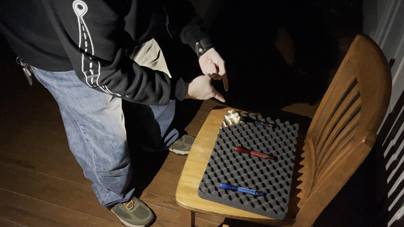 The investigation began in earnest in the central room. Since we may have gotten some kind of activity near the front door
during our initial sweep of the house, we set a chair near the front door with a piece of foam on it, and set our three
MagLite Mini flashlights on the foam. The foam was a last-minute idea, having two ideas behind it —
1) The egg crate cut on the foam would provide a stable platform for the flashlights so they don't roll around, and 2) The
foam would hopefully isolate the flashlights from any vibrations. We also added our REM Pod to the floor
in front of the chair in hopes of catching some energy pass by, and part-way through the first flashlight communication
session, a K-II EMF meter was added in the mix as well.
The investigation began in earnest in the central room. Since we may have gotten some kind of activity near the front door
during our initial sweep of the house, we set a chair near the front door with a piece of foam on it, and set our three
MagLite Mini flashlights on the foam. The foam was a last-minute idea, having two ideas behind it —
1) The egg crate cut on the foam would provide a stable platform for the flashlights so they don't roll around, and 2) The
foam would hopefully isolate the flashlights from any vibrations. We also added our REM Pod to the floor
in front of the chair in hopes of catching some energy pass by, and part-way through the first flashlight communication
session, a K-II EMF meter was added in the mix as well.
Over on our About Us page, you'll see that we follow plenty of other paranormal investigators. We follow out of fandom, of course, but over the years of watching them, we've taken some mental notes on methodology. We really like Twin Paranormal's approach to introductions, so we've modeled the beginning of our investigation after their own. Regardless of whoever shares the room with us, believer or skeptic, spirits or not, we like the idea of addressing the room as if any present spirits are live people standing there with us. The idea here is that if there are indeed spirits present, we are treating them respectfully and properly right off the bat. Introducing ourselves begins the process of building trust with any present spirits, which we believe to be helpful in garnering activity. We've seen other investigators simply start barking out commands, as if they are trying to get the spirits to perform circus tricks, and that kind of tone-deaf, abrasive behavior just doesn't sit well with us. "You'll catch more flies with honey," so to speak.
The initial flashlight communication session didn't seem like anything intelligent was interacting with us. All three flashlights were turning on and off seemingly at random. One or two questions received what appeared to be direct responses, but given how the whole session went, we can only assume those "responses" were random activity as well. That being said, the activity was particularly interesting, especially when you consider the previous activity with the motion-tracking action cam and the EMF meter in that immediate area. Something was causing all that activity, but the best possible result we can give was that there is some kind of residual energy in that space. Also considering the space is the front door of the house, it would make sense that a lot of energy would fill that space. There are systems of belief that suggest physical doors can act as portals on a spiritual plane, but even disregarding that, lots of people would have passed through that doorway, and in the days of the American Civil War, some of those people were wounded soldiers, some of which likely knew they would never leave. That's a lot of fear, anxiety, and pain coming into the space. The video below shows the entire first flashlight communication session.
The investigation then moved to the oldest section of the house, in a room currently set up like a dining room. There weren't any particular claims associated with this section of the house or the room we were in, but we figured we'd cast a wide net. We attempted a second flashlight communication session, and we got the same kind of responses as before — more random activity, but to a far less frequent degree.
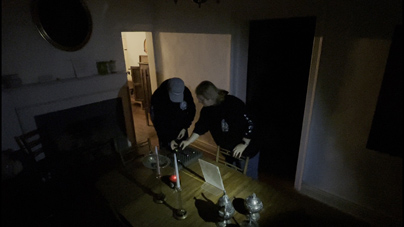 Like before, we also had our REM Pod set out, but we were surprised to find that the temperature probe was set
off pretty quickly into the session. Worth noting here, our REM Pod didn't go off at all during our investigation of Waverly Hills Sanatorium,
and that location is notorious for the amount of activity it has. These devices are known to not go off lightly, so with the low
activity from the flashlight communication in this room, we were automatically dubious of any potential paranormal influence on
the device. Dianna walked over to one of the nearby windows and found that there was a cold draft in the area, which would have
easily set off the REM Pod's temperature probe. A quick and easy debunking of equipment activity right on the spot, though I
would be lying if I said I wasn't at least a little happy to see the expensive device actually go off during an investigation
(even from natural causes).
Like before, we also had our REM Pod set out, but we were surprised to find that the temperature probe was set
off pretty quickly into the session. Worth noting here, our REM Pod didn't go off at all during our investigation of Waverly Hills Sanatorium,
and that location is notorious for the amount of activity it has. These devices are known to not go off lightly, so with the low
activity from the flashlight communication in this room, we were automatically dubious of any potential paranormal influence on
the device. Dianna walked over to one of the nearby windows and found that there was a cold draft in the area, which would have
easily set off the REM Pod's temperature probe. A quick and easy debunking of equipment activity right on the spot, though I
would be lying if I said I wasn't at least a little happy to see the expensive device actually go off during an investigation
(even from natural causes).
 Since we weren't getting much activity in the dining room, we decided to turn our efforts to the surgery room. Like the dining
room, there weren't any particular claims associated with this room, but if there was to be any trauma-related energy lingering
about, it likely would have been in this room. This is also one of the rooms that suffers from the funhouse effect,
where the floor noticeably slopes toward the outer wall, and one of the doorways is askew. We continued the flashlight communication
method in this room, and just like the two rooms before, the flashlight activity was too random to assume anything more than residual
energy was affecting them (though it was more active than the dining room). We also decided to bring out the voice recorder to see
if we could capture some Electronic Voice Phenomena (EVP). We tried several sessions, the first of which we invited any potential
spirits to speak their mind without any questions or prompts. The sessions that followed all had questions to which we hoped to receive
some kind of response. Unfortunately, one of the sessions was ruined by a car driving by outside, and the others didn't return any EVPs.
We did learn after the fact, however, that the speaker on the voice recorder is fairly low fidelity, so any EVP detection would have
to be done on our computer with headphones. More on that below.
Since we weren't getting much activity in the dining room, we decided to turn our efforts to the surgery room. Like the dining
room, there weren't any particular claims associated with this room, but if there was to be any trauma-related energy lingering
about, it likely would have been in this room. This is also one of the rooms that suffers from the funhouse effect,
where the floor noticeably slopes toward the outer wall, and one of the doorways is askew. We continued the flashlight communication
method in this room, and just like the two rooms before, the flashlight activity was too random to assume anything more than residual
energy was affecting them (though it was more active than the dining room). We also decided to bring out the voice recorder to see
if we could capture some Electronic Voice Phenomena (EVP). We tried several sessions, the first of which we invited any potential
spirits to speak their mind without any questions or prompts. The sessions that followed all had questions to which we hoped to receive
some kind of response. Unfortunately, one of the sessions was ruined by a car driving by outside, and the others didn't return any EVPs.
We did learn after the fact, however, that the speaker on the voice recorder is fairly low fidelity, so any EVP detection would have
to be done on our computer with headphones. More on that below.
Unlike the previous two rooms we investigated, there was a claim associated with the upstairs. The claim is that you can hear footsteps in the upstairs portion of the house from downstairs. Due to the amount of noise pollution around and inside the house, we had no way of testing the claim in particular, but the claim speaks of activity upstairs regardless. Upstairs, there are two rooms: The larger of the two contains racks of artifacts stored onsite, some of which were from the house, some were brought in. Among the artifacts were an assortment of guns and sabers from the Civil War, so like below in the surgery room, if there was to be any energy tied to anything in that room that might boost activity, that rack of weapons would be a prime suspect.
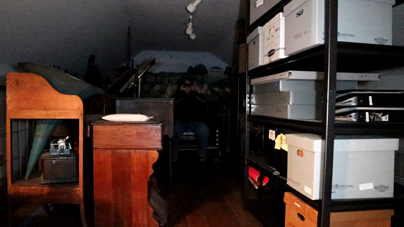 Having investigated three of the rooms downstairs with flashlight communication, we wanted to change our investigative method a bit,
so we opted to try out the Estes Method upstairs. The Estes Method has two main components. The first is what is
referred to in the paranormal community as a "Spirit Box." A Spirit Box, while having a borderline phony-sounding name, is simply an
AM/FM radio with the ability to cycle through radio stations rapidly. It started as an old off-the-shelf Radio Shack
radio that had been modified (which you can still make today, called a "Hack Shack"), and over the years it has seen different repackaging
and marketing specifically to ghost hunters. The theory is that spirits can manipulate radio frequency to speak,
and it's one of the oldest "modern" methods of investigating the paranormal, even dating back to World War II-era short wave radios.
The second component to the Estes Method is sensory deprivation. Certainly there are numerous ways of accomplishing
this, but the common way utilizes noise-cancelling headphones and some kind of blindfold or sleep mask. The idea behind the added sensory
deprivation is that you are removing external bias and allowing yourself to focus on what you hear. Additionally, some investigators
find that the sensory deprivation allows them to zone out and enter a trance-like state, possibly enhancing their focus. This investigation
would be our first time trying out the Estes Method, however, so it was very much a learning experience on our part.
Having investigated three of the rooms downstairs with flashlight communication, we wanted to change our investigative method a bit,
so we opted to try out the Estes Method upstairs. The Estes Method has two main components. The first is what is
referred to in the paranormal community as a "Spirit Box." A Spirit Box, while having a borderline phony-sounding name, is simply an
AM/FM radio with the ability to cycle through radio stations rapidly. It started as an old off-the-shelf Radio Shack
radio that had been modified (which you can still make today, called a "Hack Shack"), and over the years it has seen different repackaging
and marketing specifically to ghost hunters. The theory is that spirits can manipulate radio frequency to speak,
and it's one of the oldest "modern" methods of investigating the paranormal, even dating back to World War II-era short wave radios.
The second component to the Estes Method is sensory deprivation. Certainly there are numerous ways of accomplishing
this, but the common way utilizes noise-cancelling headphones and some kind of blindfold or sleep mask. The idea behind the added sensory
deprivation is that you are removing external bias and allowing yourself to focus on what you hear. Additionally, some investigators
find that the sensory deprivation allows them to zone out and enter a trance-like state, possibly enhancing their focus. This investigation
would be our first time trying out the Estes Method, however, so it was very much a learning experience on our part.
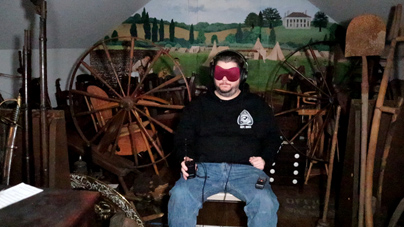 We did four different Estes Method sessions. During the Estes Method, the listener is listening for clear and full words,
as well as what may come through "behind the static." The latter of the two evidently takes some practice, though two of our sessions revealed
a deep, male murmuring. More on that later. Meanwhile, as the listener listens to the radio, someone else is addressing the room, asking
questions of any potentially present spirits and directing them to speak through the listener. Our first response during Jessica's session
was "death in the house," which seemed surprisingly relevant. For the next few moments, we continued to receive incredibly
relevant responses, some of which focused on "wanting to move on" and "being free." If we were indeed
communicating with some spirit, we wanted to be upfront and honest, so we explained that we are not able to cross spirits over. From there,
we continued to receive responses across three other sessions, most of which lacked cohesion, but were interesting nonetheless. During my
own session, I (David) evidently received responses from a Fred who thought I was a bit disrespectful. Was I talking to Fred through Jessica
earlier? Did he think I was disrespectful for reaching out to him without the ability to help him cross over? Who is to say? Aside from the
few cohesive responses we got, the most interesting feedback we got from our Estes Method sessions is that both Jessica and Dianna reported
hearing a deep, male voice murmuring under the static. Neither of them could make out what was being said, but the critical
part is that Jessica was using FM radio while Dianna was using AM. For the same male voice to show up under the static on different
radio wave modulations is curious to say the least. Was it Fred again?
We did four different Estes Method sessions. During the Estes Method, the listener is listening for clear and full words,
as well as what may come through "behind the static." The latter of the two evidently takes some practice, though two of our sessions revealed
a deep, male murmuring. More on that later. Meanwhile, as the listener listens to the radio, someone else is addressing the room, asking
questions of any potentially present spirits and directing them to speak through the listener. Our first response during Jessica's session
was "death in the house," which seemed surprisingly relevant. For the next few moments, we continued to receive incredibly
relevant responses, some of which focused on "wanting to move on" and "being free." If we were indeed
communicating with some spirit, we wanted to be upfront and honest, so we explained that we are not able to cross spirits over. From there,
we continued to receive responses across three other sessions, most of which lacked cohesion, but were interesting nonetheless. During my
own session, I (David) evidently received responses from a Fred who thought I was a bit disrespectful. Was I talking to Fred through Jessica
earlier? Did he think I was disrespectful for reaching out to him without the ability to help him cross over? Who is to say? Aside from the
few cohesive responses we got, the most interesting feedback we got from our Estes Method sessions is that both Jessica and Dianna reported
hearing a deep, male voice murmuring under the static. Neither of them could make out what was being said, but the critical
part is that Jessica was using FM radio while Dianna was using AM. For the same male voice to show up under the static on different
radio wave modulations is curious to say the least. Was it Fred again?
Here's where we hit a spat of bad luck during the investigation. During our data review, we found that almost all our video from our Estes Method sessions lacked sound, and we aren't sure why. It could be there was some fluke in the recording (we found the last video had some sound part-way through), or it could be a hardware issue. It is a well-documented phenomemon in the realm of paranormal investigation that analog and digital recordings can be wiped clean, but we don't believe anything like that occurred. It was likely some kind of human error on our part, but with the new camera setup and videography not yet being our forte, we just don't have the knowledge to say what the cause was. However, we didn't leave the Estes Method sessions empty-handed. During my session, I opted to run our voice recorder while I was listening. While I was listening for words from the radio, the voice recorder would (hopefully) capture any EVPs. We didn't capture any identifiable words on the voice recorder, and the last half of the recording was contaminated with talking in the background, but we did managed to capture a brief inhale and exhale. The audio of that breath has been posted here, we recommend you listen with the sound up, and/or with good quality headphones. The inhale is a bit quiet, and the exhale has a swishing sound layered on top of it. Full disclosure, the volume on the audio has been increased to make it easier to hear, but no filters or enhancements have been made to it.
Our Results
One of Seeking Beyond's core tenets is "No Result IS a Result," which speaks to the commonly held idea in paranormal investigation that investigators should go into a location without any expectations of capturing anything. On the one hand, it serves to temper the investigator against any personal bias and acts as a reminder that a majority of locations just don't have the kind of paranormal activty we'd all love to see — if any at all. On the other hand, if the investigators hold true to that tenet, a client can rest easy knowing the investigators aren't there to provide confirmation bias.
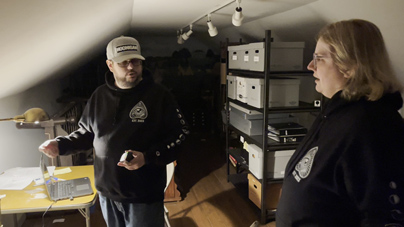 Pope's Tavern, with its rich history and numerous onsite deaths during the Civil War, has plenty of potential for paranormal activity, so it's
certainly a great location to investigate. Objectivity, however, calls for us to keep in mind that potential doesn't
always mean realization, and part of a paranormal investigator's job is to sift through the lore to reveal the facts. Many of the claims
we came across when conducting our initial research simply aren't verifiable, and some might even be exaggeration or the result of personal bias
(i.e. believing the house is haunted, so a disembodied voice heard one late might must be a spirit). Some claims might even be closer to "spooky
ghost stories" than being anything remotely related to the reality of the space (we're looking at you, disappearing bloodstains).
Pope's Tavern, with its rich history and numerous onsite deaths during the Civil War, has plenty of potential for paranormal activity, so it's
certainly a great location to investigate. Objectivity, however, calls for us to keep in mind that potential doesn't
always mean realization, and part of a paranormal investigator's job is to sift through the lore to reveal the facts. Many of the claims
we came across when conducting our initial research simply aren't verifiable, and some might even be exaggeration or the result of personal bias
(i.e. believing the house is haunted, so a disembodied voice heard one late might must be a spirit). Some claims might even be closer to "spooky
ghost stories" than being anything remotely related to the reality of the space (we're looking at you, disappearing bloodstains).
After our initial meeting with Pope's Tavern management, we were ready to spend the evening debunking claims and getting a schooling in expectations. However, we were delighted to discover that there is some kind of activity present, although we can't say with any certainty that it's intelligent to any degree, or even related to the history of the house at all. The most we can say for now is that the activity we encountered is residual at best, if not merely indicative of some kind of anomalous energy. More investigations over a longer period of time and under more controlled circumstances might reveal more discernable activity. One common reality of paranormal investigation is, if we hold the idea that spirits are just people, any present spirits are certainly subject to the ideas of hesitency and uncertainty, making it so trust has to be nurtured over time. Oftentimes investigators get minimal or no activity on their first visit, but observe increased activity on subsequent visits as familiarity and trust build. That being said, the highlights of our evening are listed below.
- Sound-related claims are unverifiable due to noise pollution
- Surgery room and upstairs exhibit elements of the funhouse effect
- Flashlight communication activity indicate possible residual activity
- Curious EMF meter activity by front door and upstairs
- Curious motion-tracking camera activity by front door
- Some relevant Estes Method responses, mostly incohesive responses
- EVP of an inhale and exhale captured
Would we have loved to see the reported apparition of a nurse making her rounds? Absolutely. But sometimes fish just don't bite. Are we happy with our results regardless? Again, absolutely. This was our first ever private investigation, so every second of it was a learning experience. There are things we'd change going forward, there are aspects of investigation we certainly still need practice to improve. There are logistical concerns that need addressing. Trying to manage ghost hunting equipment, camera equipment, batteries, placement, people, travel, timing, communication... it's a LOT of work. Everything can improve overall, but we are still basically brand new to this and we have several more opportunities coming up this year that we can use to do just that. Overall, our investigation of Pope's Tavern was an amazing experience. It was a nice, controlled environment we could use to work on our methodology and get a feel for just doing the work.
We would like to express our appreciation and gratitude to Brian Murphy, Director of Florence Arts and Museums for giving us this fantastic opportunity. We would also like to thank the wonderful staff and volunteers of Pope's Tavern for facilitating our investigation. It is our hope that our work and results reveal just a little bit of the unknown and add to the story of Pope's Tavern.
by David Reimer, posted February 6, 2024
Additional Photos
Please click on each image to enlarge. Use left and right arrows to navigate. Info in captions.
